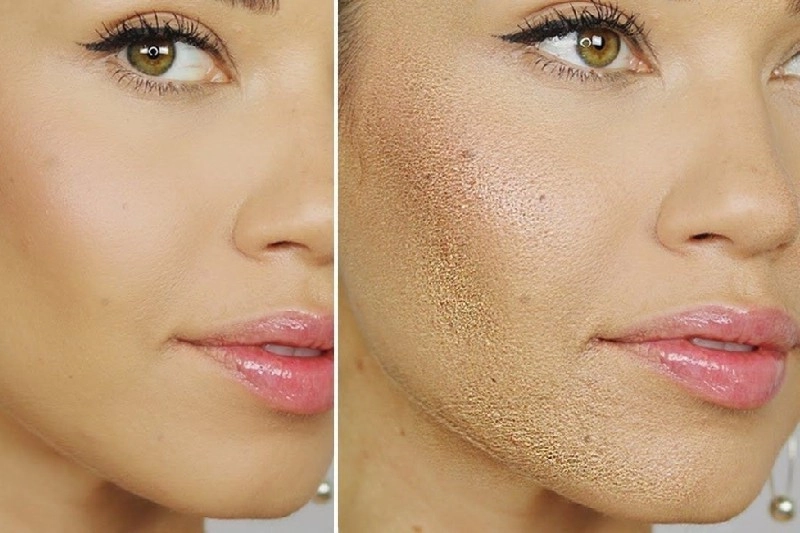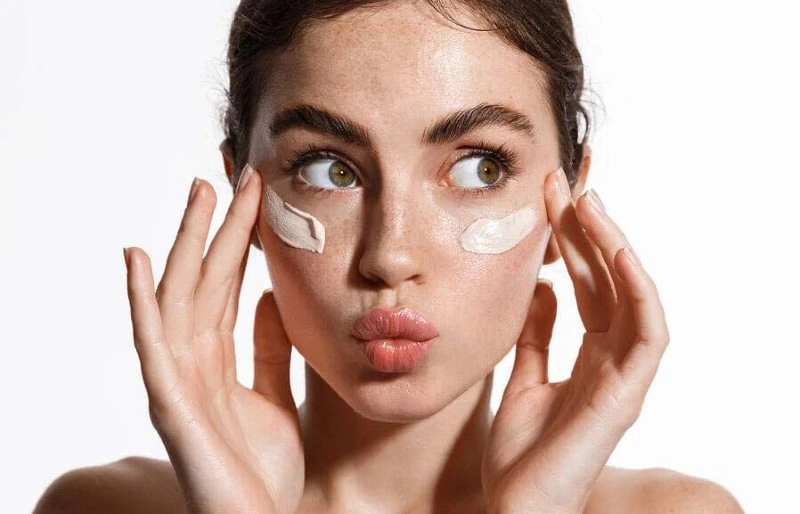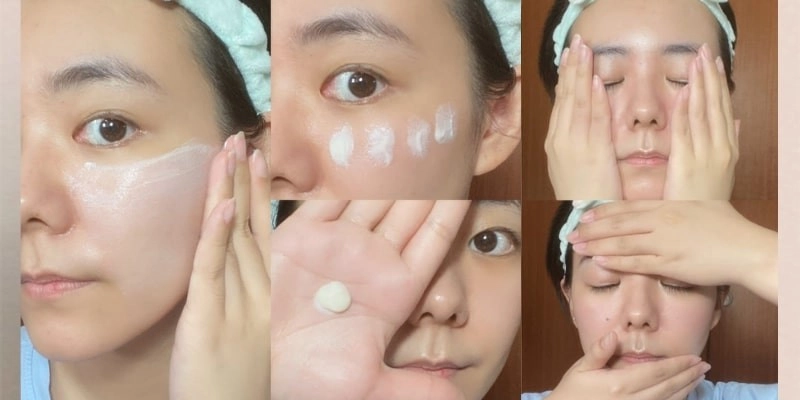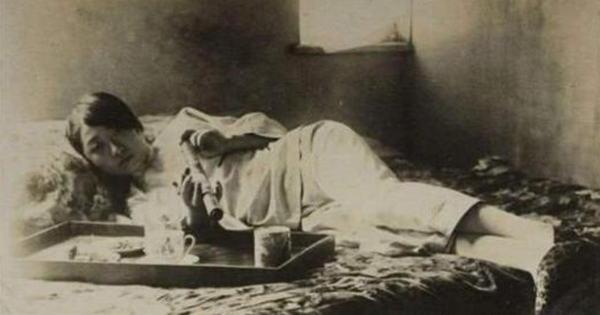- Why does applying sunscreen cause the tone to decrease?
- Cause
- How to deal with sunscreen that has lost its tone
- How to properly apply sunscreen for natural tone
- Suggest some sunscreens to improve skin tone
- Related questions
- Why do I still get dark spots when I apply sunscreen?
- What should I apply before applying sunscreen?
- Applying sunscreen in the morning and noon, do I need to remove makeup?
- How many times a day should I apply sunscreen?
- What steps should I apply sunscreen before and after?
Applying sunscreen and its tone fading is a problem that many people encounter when using this product. The cause may be that the sunscreen is not suitable for your skin type, does not provide enough protection, or reacts with other ingredients in the skin care routine. To solve this problem, you need to learn carefully about the sunscreen you are using, as well as how to apply it and how often to apply it. The following article will provide you with useful information on how to choose and use sunscreen effectively, to have bright, healthy skin and not experience skin tone loss.
Why does applying sunscreen cause the tone to decrease?
Cause
Applying sunscreen is one of the important steps to protect your skin from the harmful effects of UV rays. However, many people often experience a decrease in skin tone after applying sunscreen.
 The condition of sunscreen application has decreased in tone
The condition of sunscreen application has decreased in tone
The cause of sunscreen fading may be due to:
Sunscreen is not suitable for skin type
There are two main types of sunscreen: chemical sunscreen and physical sunscreen. Chemical sunscreens have the ability to penetrate deep into the skin and react with UV rays to prevent them from damaging the skin. Physical sunscreen has the ability to reflect UV rays and create a protective layer on the skin's surface. If you have sensitive skin, you should choose physical sunscreen to avoid skin irritation. If you have oily skin, you should choose chemical sunscreen to avoid clogging pores. In addition, you also need to choose the SPF (Sun Protection Factor) level appropriate to your level of sun exposure. The higher the SPF level, the better the ability to protect the skin, but it can also cause a sticky feeling and difficulty penetrating the skin.
Sunscreen is not compatible with other cosmetics
When using sunscreen, you need to pay attention to the order and compatibility of other cosmetic products. You should apply sunscreen after applying serum, moisturizer or primer. At the same time, choose cosmetic products that have the same active ingredients as sunscreen to avoid chemical reactions on the skin that cause the sunscreen to lose its tone. For example, if your sunscreen has oxybenzone as the active ingredient, you should avoid using products with avobenzone or octinoxate as the active ingredients.
Applying too little or too much sunscreen
The amount of sunscreen needed to effectively protect the skin is about 2mg/cm2, equivalent to a green pea-sized amount of cream for each face. If you apply too little sunscreen, you will not achieve the SPF index listed on the product and will not have enough of a protective layer on your skin. If you apply too much sunscreen, it will cause stickiness, visible texture or skin tone.
Not applying sunscreen evenly
You need to apply sunscreen to your entire face and neck, including areas like your ears, nose, eyelids, and lip edges. If you miss these areas, your skin will lose tone in unprotected areas. You also need to apply sunscreen from the inside out and from bottom to top to ensure the cream is absorbed evenly into the skin.
Not reapplying sunscreen properly
Sunscreen is only effective for a certain period of time, usually 2 to 4 hours depending on the type of cream and your activities. If you are exposed to sunlight continuously or sweat, you need to reapply sunscreen every 2 hours to maintain effective skin protection. If you do not reapply sunscreen properly, your skin will be damaged by UV rays and lose its tone.
How to deal with sunscreen that has lost its tone
 How to deal with sunscreen that has lost its tone
How to deal with sunscreen that has lost its tone
Applying sunscreen is an important step in protecting your skin from sun damage. However, many people encounter the problem of sunscreen losing its tone, causing the skin to become gray, dull and uneven. This is because the sunscreen does not dissolve with the skin or reacts with other skin care products or makeup. To handle this situation, you can refer to the following ways:
- Choose a sunscreen suitable for your skin type and intended use. You should choose a sunscreen with a high SPF index, is able to protect against UVA and UVB rays, has moisturizing ingredients and does not cause skin irritation.
- Clean your skin before applying sunscreen. You should exfoliate at least once a week to remove dead skin layers, dirt and sebum accumulated on the skin, helping sunscreen to penetrate easily and not lose tone.
- Apply sunscreen at least 15 minutes before going outside to give it time to absorb into the skin, reapply every two hours or when sweating heavily.
- Use skin care or makeup products with sunscreen properties such as primer, powder or lip balm to increase skin protection from the sun.
- Use oil-absorbing paper or powder to control sebum and maintain skin tone.
How to properly apply sunscreen for natural tone
 Some steps to apply sunscreen
Some steps to apply sunscreen
To use sunscreen effectively to enhance tone, apply the following steps:
Apply cream before going out:
Wet your skin before applying sunscreen about 30 minutes before leaving the house. Applying a thin layer will help the cream absorb better, avoiding a greasy feeling because the cream hasn't had time to absorb.
Dot 5 points evenly on the face:
Dot sunscreen on 5 points on the face and apply evenly in a circular or spiral shape. This ensures even coverage of the cream over the entire facial area, but be careful with creams with thick, dense textures that can cause cakey and clumping.
Pat the cream with your palm:
Pat an even amount of sunscreen onto your face with the palm of your hand after rubbing the cream on your hands. This method saves time and avoids wasting cream. However, pay attention to applying carefully to the nose, nostrils and eye areas.
Dot directly onto skin:
Take a small amount of sunscreen and dot it directly onto the spots on your face, then apply evenly. This helps you estimate the amount of cream to use effectively and without causing waste.
Apply evenly and massage:
Apply the cream evenly to points on the face and perform uniform massage movements. For liquid sunscreen, this operation will be easier than for solid cream. If the cream dries quickly, quickly spread it evenly to avoid the cream drying out before applying it evenly. The above steps help you apply sunscreen effectively, keeping the natural tone of your skin without creating a heavy feeling. causes clogged pores.
Suggest some sunscreens to improve skin tone
|
Product name |
Outstanding features |
Scoring |
Best place to buy |
| Anessa Brightening UV Sunscreen Gel |
Brightens, tones and corrects skin tone. Moist, cool and smooth gel texture helps maintain skin moisture Prevents signs of skin aging caused by UV rays, protects skin against the harmful effects of fine dust (suitable for dry, dull skin, brown spots, freckles) |
8.5/10 |
LAZADA SHOPEE |
| Cell Fusion C Brightening Tone Up Sunscreen |
Protects skin from sunlight, improves elasticity. Lightens dark spots, melasma, dark spots and enhances skin tone. Can be used instead of makeup primer every day |
8.5/10 |
LAZADA SHOPEE |
| L'Oreal UV Defender Bright & Clear (pink label) |
Maximum sun protection, prevents skin from aging for up to 5 years. Reduce dark spots The perfect combination of maximum durable sunscreen technology and gold ingredient that protects the skin and whitens and reduces dark spots – Niacinamide. |
8.25/10 |
LAZADA SHOPEE |
| La Roche Posay Uvidea Anthelios Tone-Up Rosy |
Comprehensive skin protection against the effects of UV rays and environmental influences. Helps tone and brighten skin, especially skin with many dark pigmentation problems Natural white and pink tones are suitable for dull skin and yellow Asian skin tones. |
8.25/10 |
LAZADA SHOPEE |
| BEPLAIN Sunmuse sunscreen |
Protects skin with SPF 50+ PA++++ All day tone-up effect, no tone down, no oil Not sticky, waterproof, does not leave white streaks. |
8/10 |
SHOPEE |
| Innisfree Tone Up No Sebum Sunscreen EX |
Physical sunscreen filter, helps protect skin optimally. Provides outstanding tone-enhancing and oil-controlling effects, maintaining rosy, smooth skin for 24 hours. Clean formula for all skin types. |
8/10 |
LAZADA SHOPEE |
| The Saem Eco Pink Sun Cream |
Sun protection index SPF50+/PA++++, has outstanding ability to protect skin from UVA and UVB rays. The cream is thin and silky, absorbs quickly and does not cause stickiness on the skin. Provides nutrients to the skin, balances moisture, and helps skin naturally brighten when used. Can be used as foundation for girls who like light, natural makeup. |
7.75/10 |
LAZADA SHOPEE |
| Some By Mi Truecica Mineral Calming |
High sun protection index SPF 50+ PA++++ has the effect of protecting the skin and brightening the skin without losing its natural look. Skin irritation test completed. Does not contain 20 types of toxic ingredients. Safe for acne-prone and sensitive skin. |
7.75/10 |
LAZADA SHOPEE |
| Sunplay Skin Aqua Tone Up UV Milk | Protects against all UV rays – Natural coverage Enhances clear, radiant skin tone Use daily, exclusively for facial skin |
7.5/10 |
LAZADA SHOPEE |
| Reihaku Hatomugi Japan |
Sun protection for naturally white and pink skin, bright and smooth skin. Moisturizing ingredients extracted from natural ingredients are very safe for the skin, even sensitive skin. Sunscreen has no odor, no color, suitable for use with sensitive skin. |
7.5/10 |
LAZADA SHOPEE |
Related questions
Why do I still get dark spots when I apply sunscreen?
Applying sunscreen is one of the important measures to protect the skin from the harmful effects of ultraviolet rays. However, not everyone who applies sunscreen can avoid dark skin. That's because there are many other factors that affect skin pigmentation such as genetics, diet, level of sun exposure, type of sunscreen and how to use sunscreen. To minimize the risk of dark skin when applying sunscreen, you need to note the following:
- Choose a sunscreen that suits your skin type and activities.
- Apply sunscreen properly and in sufficient quantity.
- Avoid sun exposure between 10 a.m. and 4 p.m., when ultraviolet rays are most intense. You should also wear a wide-brimmed hat, sunglasses, and clothing that covers your skin when outdoors. Drink enough water and eat lots of foods rich in vitamin C and E to keep your skin healthy and bright.
What should I apply before applying sunscreen?
Before applying sunscreen, you need to clean your face and neck with a cleanser suitable for your skin type. After that, you should use toner to balance the pH and tighten pores. The next step is to moisturize the skin with cream or serum. You should wait about 15 minutes for skin care products to penetrate the skin before applying sunscreen. Sunscreen is the last step in your morning skin care routine. You should choose a sunscreen with an SPF index of at least 30 and PA+++ or higher to protect your skin from harmful UVA and UVB rays.
Applying sunscreen in the morning and noon, do I need to remove makeup?
If you have oily, acne-prone or sensitive skin, you should remove makeup after applying sunscreen at noon to remove dirt, sebum and chemical ingredients that can irritate the skin. You can use gentle makeup remover or gentle cleanser to clean your skin. Afterwards, you should reapply sunscreen to maintain effective skin protection.
If you have dry or normal skin, you may not need to remove makeup after applying sunscreen at noon, unless you are exposed to polluted environments or sweat a lot. You just need to gently wipe your skin with a tissue or damp cotton pad to remove old sunscreen and dirt. Afterwards, you should reapply sunscreen to maintain effective skin protection.
How many times a day should I apply sunscreen?
Some basic rules about when to apply sunscreen effectively are:
- Apply sunscreen at least 15 minutes before going outside, allowing the cream to penetrate the skin and take effect.
- Reapply sunscreen every 2 hours or after swimming, sweating or toweling.
What steps should I apply sunscreen before and after?
Order of applying sunscreen:
- Step 1: Clean with makeup remover and facial cleanser
- Step 2: Use toner
- Step 3: Moisturize the skin
- Step 4: Apply sunscreen
- Step 5: Reapply sunscreen
In short, skin tone drops due to many different reasons such as cream quality, application method, application time or skin condition. To solve this problem, you need to choose sunscreen suitable for your skin type and purpose of use, apply enough amount and evenly on your face, apply 15-20 minutes before going out in the sun and reapply every 2-3 hours. In addition, you should also take care of your skin properly, drink plenty of water and avoid direct exposure to sunlight for too long. Hopefully this article, Chanh Tuoi Review, has helped you better understand the causes and how to fix the problem of sunscreen fading. Thank you for following!
>>> See more: Tips on how to protect yourself from the sun without cream, simply and effectively





![[Cập Nhật] Bảng Giá Trầm Hương Mới Nhất Hiện Nay 2024 [Cập Nhật] Bảng Giá Trầm Hương Mới Nhất Hiện Nay 2024](https://anthienhuong.com/wp-content/uploads/2022/11/tram-huong-gia-bao-nhieu-2.jpg)



















Ý kiến bạn đọc (0)